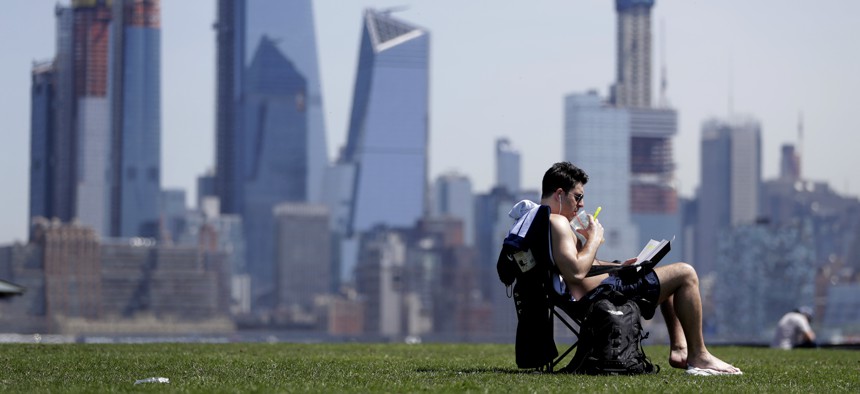The East Coast Is Going to Get Arkansas-ified

Part of the New York City skyline gives backdrop to a man as he sips on a drink while sunbathing on a warm day at Pier A Park on May 2, 2018, in Hoboken, N.J. AP Photo
A new study finds the climate “twin city” for hundreds of places across the United States.
Sixty years from now, climate change could transform the East Coast into the Gulf Coast. It will move Minnesota to Kansas, turn Tulsa into Texas, and hoist Houston into Mexico. Even Oregonians might ooze out of their damp, chilly corner and find themselves carried to the central valley of California.
These changes won’t happen literally, of course—but that doesn’t make them any less real. A new paper tries to find the climate-change twin city for hundreds of places across the United States: the city whose modern-day weather gives the best clue to what conditions will feel like in 2080. It finds that the effects of global warming will be like relocating American cities more than 500 miles away from their current location, on average, mostly to the south and toward the country’s interior.
For instance, the Philadelphia of the 2080s will resemble the historical climate of Memphis. By the time kids today near retirement age, Philadelphia’s average summer will be about 7 degrees Fahrenheit warmer than it is now. Winters in Philly will be nearly 10 degrees more temperate. Memphis’s scorching, sticky weather provides the best guide to how those climatic changes will feel day after day.
Meanwhile, Memphis’s climate will come to resemble that of modern-day College Station, Texas, by 2080.

The paper was accompanied by the release of a new tool that lets Americans find their city’s climate-change twin.
“Everything gets warmer,” says Matthew Fitzpatrick, an author of the paper and a professor at the University of Maryland Center for Environmental Science. “I don’t think I’ve seen a place that doesn’t.” In the West and Midwest, cities also tend to get drier as the Great Plains shift east. So Chicago comes to Kansas, Denver drifts to Texas, and San Francisco starts to feel like Los Angeles.
Fitzpatrick cautions that no city will perfectly match its climate twin, especially when it comes to rainfall. Many cities in the South simply do not have a good twin: “The climate of many urban areas could become unlike anything present” in North America, the paper says.
In the Northeast, you can envision the future as one big Arkansas-ification. The paper finds that if the world meets its goals under the Paris Agreement, then Washington, D.C., will enter the 2080s feeling a lot like Paragould, Arkansas. But if the world follows a worst-case scenario, then D.C. will more closely resemble northern Mississippi—and New York City will feel like Jonesboro, Arkansas.
That worries Virginie Rolland, a resident of Jonesboro and a professor of ecology at Arkansas State University. “That’s in line with what I know, that the eastern U.S. will become hotter and wetter, while the [Midwest] will become drier and hotter,” she told me. Her own research focuses on eastern bluebirds, which have historically spent the summer in New York before migrating south for the winter. But “they’ve started staying in New York” for the winter, she said, “so I know it’s getting warmer there.”
She also warned future New Yorkers about what Jonesboro has in store: “Summer-wise, it’s like Florida here. And I cannot imagine New York like Florida … it’s hard to think about how humid it will be.”
“I wouldn’t wish the hot and humid summer climate of Arkansas on anyone,” agreed David Stahle, a climate scientist at the University of Arkansas, in an email.
“I was shocked, to be honest,” at how southerly many cities would soon feel, Fitzpatrick told me. The research spun out of his own weather worries: “I really like snow, and I thought, Is that still going to happen up here?” he said. But when he looked up his current home in Cumberland, Maryland, he found that it would soon feel like southern Kentucky. He groaned. “I lived in Knoxville for several years, in central Tennessee, when I was doing my Ph.D., and I couldn’t wait to get out of there because it was so hot and humid. I thought, Ugh, the climate’s following me up here.”
Even though Fitzpatrick works with climate data all the time—and knew, as he put it, that “it’s gonna get warmer, whatever”—he had never thought about it like this. “If I have grandkids and they lived in the same place I do,” he said, “they might not recognize this climate that we’re living in now.”
Robinson Meyer is a staff writer at The Atlantic, which originally published this article.
NEXT STORY: Bike Share Continues to Have an Equity Problem






